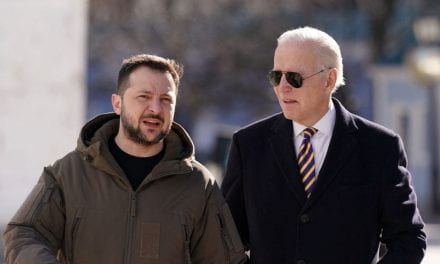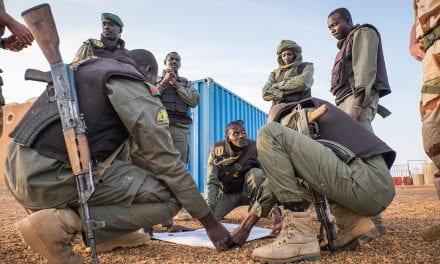Russia’s Response to the Challenges of Urban Warfare in the Russo-Ukrainian War
The Russo-Ukrainian War has resulted in high casualties on both sides in addition to producing a humanitarian catastrophe. Ukrainian civilians are experiencing the harsh realities of war and the Russian Federation is committing war crimes against the civilian population as well as targeting Ukrainian infrastructure. Russia’s actions are a response to their inability to succeed in urban warfare. The Russian military was not prepared for the challenges of urban warfare on the battlefield and have resorted to war crimes and targeting civilian infrastructure to give themselves an advantage in the war.
Urban warfare can be defined as combat between two opposing forces within the boundaries of cities and towns. John Spencer is a former United States Major and subject matter expert in urban combat, and he defines urban terrain as being within the presence of civilians, man-made structures, buildings, and population with infrastructure to support it.[1] Many important battles in the Russo-Ukrainian War are being fought in these areas. A distinct military advantage that the Ukrainians possess is the ability to utilize the urban terrain for their defense. For example, John Spencer highlights that infrastructure featuring concrete within the urban terrain makes it extremely difficult for the attackers, in this case the Russian military, to identify and eliminate targets via aerial and intelligence assets.[2]
Throughout the duration of the war the Russian military has struggled to adapt to the challenges that urban warfare presents. Russia’s lack of preparation for urban combat and inability to succeed on the urban battlefield has led to increased indiscriminate attacks on civilians that constitute war crimes. Urban warfare differs on the tactical and operational level because the presence of urban terrain complicates the way in which a military leads an offensive into a designated target. Urban warfare tends to have two main characteristics: The defender has the advantage on the battlefield, and close-range fighting nullifies the attacker’s advantage in firepower and technological superiority.[3] The defender maintains the advantage in urban combat because of the make-up of cities and towns. Large and tall buildings provide a force with the high ground on enemy positions as well as providing a fortress-esque structure that is highly protective, and will take a significant explosive fire to destroy. By fighting in these positions the defender is able to engage the enemy with better cover and to inflict heavy casualties from a fortified position. This happens because the defending force is able to maneuver and manipulate interior lines very effectively because of the familiarity with the terrain.[4]
Conversely, offense is fundamentally harder than defense. When an army invades they are typically met immediately by enemy gunfire, airstrikes, and other attacks as soon as they cross into enemy territory. Defenders possess the knowledge of the terrain and the ability to reinforce defensive positions. Therefore a 3:1 and sometimes suggested 6:1 advantage is typically advised as the requirement for force strength in order for a successful tactical victory.[5] In order to conduct offensive operations armies must be willing to bear the cost of high casualties in order to accomplish their objectives.
The Russian military’s invasion force was around 200,000 soldiers which made it the largest build-up of force in Europe since World War II. The Ukrainians had around 90,000 defenders (200,000 upon reserve mobilization). During February and March the force strength for the two opposing militaries were close, however, this does not account for either partisan warfare nor local volunteers.[6] Thus, it can be said with confidence that the Russian army did not possess the force advantage that they needed when they decided to invade. Again, a military axiom that is widely accepted is that the attacking force should have a 3:1 force advantage on the tactical level in order to accomplish their objectives. American military doctrine even suggests a 6:1 force advantage in order to achieve success.[7] The Russians never possessed the capability to win at the onset of the war. In cities such as Kyiv and Kharkiv, based on their populations and physical size, Russia needed to invade with a force strength significantly higher than what they possessed, especially considering the conventional and non-conventional forces of Ukraine would be increasing immediately after the realization of invasion.[8] Thus, invading a nation with about 200,000 soldiers was a terrible idea for Putin, and he never gave Russia a realistic opportunity to win the war. The urban battlefield already favors the Ukrainians and Russia should have invaded with significantly more soldiers if it wanted to defeat Ukraine on the battlefield, let alone occupy it.
Rather, Putin and the Russian army are committing war crimes in the hopes of offsetting their inability to succeed on the urban battlefield. The unfortunate attacks on civilians signal that Moscow is not confident in their capabilities, and will attempt to remedy the situation by causing damage to Ukraine and its infrastructure, while terrorizing the Ukrainian people into submission. Russia has attempted to offset the disadvantage of its force strength by engaging in intense bombardments and missile strikes on cities and towns in Ukraine, with infrastructure, residential buildings, schools, and hospitals often being the target of Russian artillery and missile systems.[9] The indiscriminate tactics and war crimes are creating a humanitarian catastrophe in Ukraine.
Russia’s barbaric war crimes and targeting of civilian infrastructure has caused one of the biggest refugee crises in Europe since the Second World War. Millions of families throughout Ukraine are being forced to either flee to other nations to assure their families safety, or endure the volatile nature of warfare from their basement. However, Europe has united around Ukraine, having sent them weapons and equipment for months, and also has taken in many of their citizens. According to the United Nations High Commission for Refugees, as of November 2022 over 7.8 million Ukrainians have become refugees in external locations.[10] Additionally, according to the Office of the UN High Commissioner for Human Rights, there have been 16,784 civilian casualties in Ukraine: 6,595 killed and 10,189 injured.[11] This figure is believed to be significantly higher but due to the war still unfolding in real time exact figures are unable to be fully calculated.
In recent months the Russian military has repeatedly weaponized winter through its targeting of civilian infrastructure. Russia has committed war crimes ranging from murder, torture, and targeted strikes on clearly defined civilian occupied buildings, as evidenced in Mariupol.[12] Russia has brought the war to the Ukrainian civilians because of their lack of confidence in their ability to win on the battlefield using conventional means and tactics. Putin and his generals have targeted Ukrainian infrastructure with the main goal restricting access to heat, electricity, and water to the Ukrainian people. Russia is attempting and succeeding in creating hardship and extreme challenges for the Ukrainian people and hopes that these attacks will lower morale amongst the population, maybe even forcing Kyiv into the negotiating table to give Russia a face-saving victory.
The Siege of Mariupol is one of the best examples of destructiveness that urban warfare entails. The siege was bloody, cruel, and targeted Ukrainian civilians, which is a common occurrence in Moscow’s war. Of Mariupol’s over 430,000 citizens, around 130,000 residents remained trapped in the city during the final months of the siege with intense bombardments and fighting occurring every day for around three months.[13] The Russian military isolated the city and on March 16, 2022 a Russian airstrike targeted a theater in downtown Mariupol that killed over 600 civilians.[14] The theater was a bomb shelter for Ukrainian civilians fleeing the bombardments. The fighting within the city finally concluded at the heavily fortified Azovstal steel plant and took the Russian army months to capture even with their advantage in force strength and firepower. Many Ukrainian civilians were stationed inside the plant because the infrastructure provided the ability to protect them better than their homes would against the Russian bombardments. In totality Ukrainian officials estimate that over 21,000 civilians have been killed in Mariupol.[15] Although this figure should be viewed skeptically given that it is unconfirmed, it is a staggeringly high estimate for civilian fatalities and one that should concern the world.
The Russo-Ukrainian War has highlighted the weakness of the Russian military. Putin and his generals have resorted to a campaign that targets civilians and infrastructure to break the will of Ukraine to resist Russian occupation as well as to atone for their failures on the battlefield. By making Ukrainian women and children survive winter without food, electricity, or heat, Putin hopes that Ukraine will lose the will to fight and ability to effectively resist Russia. He has mistakenly underestimated the resilience of the Ukrainian people and has failed to realize that committing war crimes and targeting critical infrastructure only emboldens your enemy to fight harder against you. These tactics by Russia are a direct result of their inability to win on the urban battlefield. However, the Ukrainians are proving that it will take more than causing a humanitarian catastrophe to win this war. Russia will have to revise their urban warfare military doctrine and tactics if they plan on winning the Russo-Ukrainian War through using conventional means.
References:
[1]John Spencer, “Why Urban Warfare Is The Hardest Type Of Warfare,” Modern War Institute, June 10, 2022, https://mwi.usma.edu/why-urban-warfare-is-the-hardest-type-of-warfare/.
[2]Ibid
[3]Ibid
[4]John Spencer, “The Eight Rules of Urban Warfare and Why We Must Work to Change Them,” Modern War Institute, January 12, 2021, https://mwi.usma.edu/the-eight-rules-of-urban-warfare-and-why-we-must-work-to-change-them/
[5]Louis DiMarco, “Urban Operations in Ukraine: Size, Ratios, and the Principles of War,” Modern War Institute, June 20, 2022, https://mwi.usma.edu/urban-operations-in-ukraine-size-ratios-and-the-principles-of-war/
[6]Ibid
[7]Ibid
[8]Ibid
[9]Margarita Konaev and Kirsten J.H. Brathwaite, “Russia’s Urban Warfare Predictably Struggles,” Foreign Policy, April 4, 2022, https://foreignpolicy.com/2022/04/04/russia-ukraine-urban-warfare-kyiv-mariupol/
[10]“Ukraine Refugee Situation,” Operational Data Portal, December 6, 2022, https://data.unhcr.org/en/situations/ukraine
[11]“Ukraine: Civilian casualty update 21 November 2022,” United Nations, November 21, 2022, https://www.ohchr.org/en/news/2022/11/ukraine-civilian-casualty-update-21-november-2022
[12]Mstyslav, Chernov, Lori Hinnant, and Vasilisa Stepanenko, “AP Evidence Points to 600 Dead in Mariupol Theater Airstrike,” AP NEWS, May 4, 2022. https://apnews.com/article/Russia-ukraine-war-mariupol-theater-c321a196fbd568899841b506afcac7a1.
[13]Margarita Konaev and Kirsten J.H. Brathwaite, “Russia’s Urban Warfare Predictably Struggles.”
[14]Mstyslav, Chernov, Lori Hinnant, and Vasilisa Stepanenko, “AP Evidence Points to 600 Dead in Mariupol Theater Airstrike.”
[15]Associated Press, “Smashed buildings in Mariupol produce endless caravan of death,” Politico, June 9, 2022, https://www.politico.com/news/2022/06/09/ukraine-death-bodies-mariupol-00038386#:~:text=At%20least%2021%2C000%20Mariupol%20civilians,up%20the%20price%20of%20food







